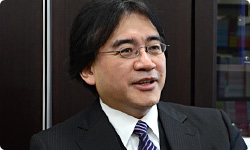In the period around 2004-2006, no clear theories had been formulated regarding the question of what happens inside our brains. As Brain Training became ever more popular, issues concerning its scientific accuracy were raised. The popularity of the games might have caused you some trouble, Dr. Kawashima.
No, no. The thing is… Brain Training was the first time someone had produced a product which claimed to use scientific information about what is occurring in the user’s brain – one which said that it stimulates the prefrontal area of the brain, basically. I thought that was pretty epochal in itself, so it’s a bit of a shame that not many people analysed that aspect of it.
Another thing I think is that although Brain Training was really valuable as a means of allowing families to communicate across generations, I don’t think much attention was necessarily paid to that aspect either.
Optical topography 3 has been used to prove that blood flow in the brain increases when one is playing Brain Training. In other words, it makes the brain work. On the other hand, what kind of changes take place in the brain afterward was not theorized at that time. I wonder how the researchers have been progressing since then.3 Optical topography is a medical procedure used to examine brain activity. It measures activity on the surface of the brain, in areas responsible for motor, language, and other functions.
Well, first of all, we have proven that if older people play Brain Training, improvements can be seen in a number of their brain functions. This was verified using a range of psychological indicators.
I see.
We have also learned that using some of the memory training software on a computer, rather than Brain Training on the Nintendo DS system, does not notably improve one’s brain functions. These other trainings than Brain Training appear as a matter of logic to train our brain, but measurements taken using optical topography show that they do not actually place a burden on the prefrontal area.
So even if you do things that initially appear to be similar to the exercises in Brain Training, you are not actually training your brain unless you simultaneously perform a number of linked processes – for example reading a problem, making a calculation, and writing the answer with the Nintendo DS stylus.
That’s right. My hypothesis is that if you can do something easily, it doesn’t place a burden on the brain and therefore does not show the training effect. Also, you can’t tell whether or not a burden is being placed on the brain unless you measure brain activity, so even if you’re doing things that look should logically be effective, there is no evidence that they are placing a burden on the brain.

I see. So you measure brain activity with a method such as optical topography, which allows you to observe blood flow within the brain and see whether or not a burden is being placed on it. I remember when we were making Brain Training, we created a number of exercises based on your theories. In the end, however, many of these exercises were discarded. There were some exercises that should logically have stimulated the brain but then we were told by you that they actually caused it to ‘cool down’. It just goes to show that it is impossible to know what stimulates the brain unless you actually measure brain activity.
That’s right. It’s impossible to know what stimulates the brain from psychology alone, which I find rather interesting. Thinking of ways to increase brain activity was a big theme during the development of Brain Training.
The brain function that Brain Training was specifically designed to improve was one’s memory processing speed. Later experiments showed that it also boosts brain capacity as well as various cognitive functions.
I would imagine that what you just said about ‘boosting brain capacity’ is hard for the layman to get their head around. Could you explain a bit more about what you mean?
Certainly. In order to understand the phenomenon of brain aging, we use a technique called MRI 4 to measure how the brains of the elderly change. For example, we can measure changes in the thickness of the layer of neural tissue called the cerebral cortex.4 MRI: Magnetic Resonance Imaging. MRI uses magnetic fields and radio waves to capture images of the inside of the body.
I suppose it weakens with age?

Yes. It usually becomes thinner. The cerebral cortex is at its thickest at around 8-10 years of age, and after that it becomes thinner. Until around 20 years of age, this thinning is as a result of consolidation, but after that, it is thought that aging actually causes the cortex to shrink. This means it is a natural process.
I see.
Around the turn of the millennium, however, a research paper suddenly appeared in a journal called Science5, claiming that juggling can cause the areas of the brain responsible for sensing movement, the parietal lobe and temporal lobe, to increase in capacity. It was the first scholarly paper that claimed to have visually witnessed brain change happening.5 Science is an academic journal that has been published by the American Association for the Advancement of Science since 1880.
Oh yes?
Well, just like with juggling, we understand, psychologically, that using Brain Training causes changes to occur in your brain network, and that it improves your brain functions.
Brain Training was designed to train the brain’s processing time, but this new software title, Devilish Brain Training, increases the capacity of your ‘working memory’6. In other words, we have tried to create a training programme that increases the amount of information you can store in your head in the short-term.6 ’Working memory’ refers to the memory process for temporarily holding, manipulating and using information. It is a brain function that checks goal-oriented memorised material against multiple pieces of stored information and responds appropriately.
So, your ‘working memory’ contains information that you temporarily memorise and then recall. Quickly memorising a phone number and then forgetting it after you’ve written it down would be one example – a feature, you might say – of your working memory in action.
Exactly. Working memory capacity is the most difficult part of the brain to train. To a certain extent, your memory capacity is actually fixed, regardless of age or gender – though people we consider to be ‘intelligent’ tend to have higher capacities.
When we asked university students to perform working memory training for 20-60 minutes every day, we found that the capacities of their prefrontal areas – the areas responsible for high-level brain functions – had increased in both the left and right lobes. Surprisingly, we found that their levels of creativity had increased as well.
© 2024 Nintendo.